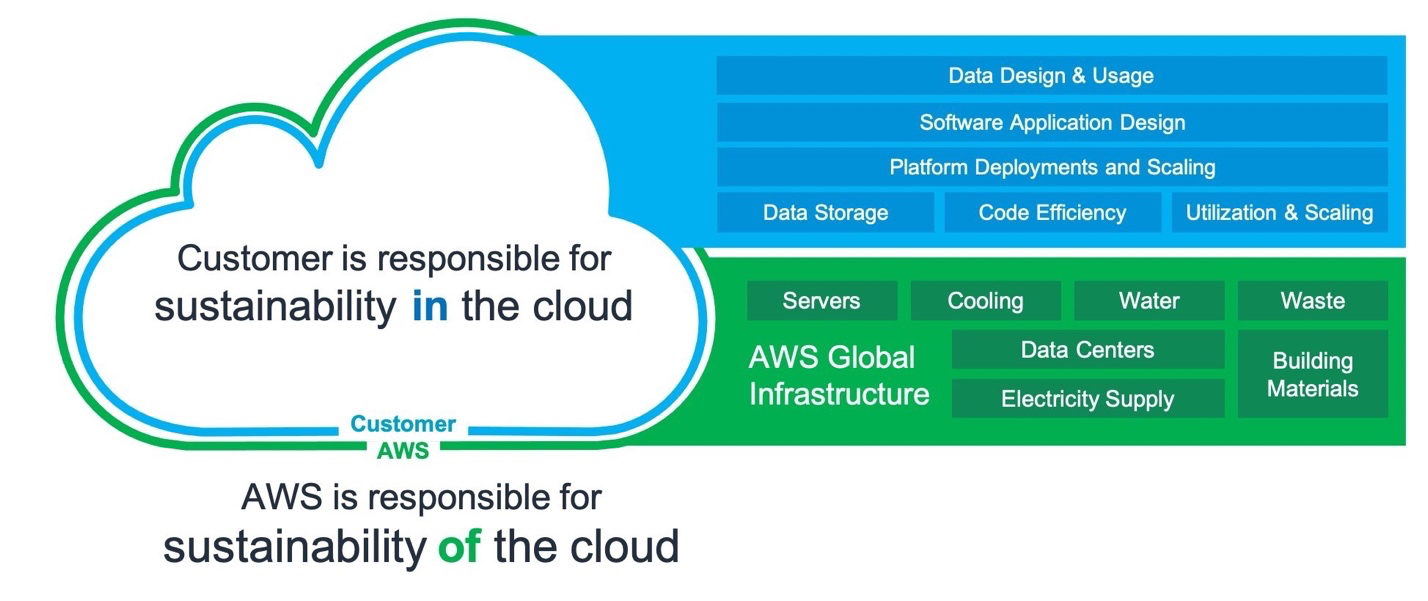Cloud sustainability and AWS
One of our major challenges today is climate change and what we can do about it. Some activities we discuss that we ourselves can affect directly or indirectly may include:
- Avoid travel by air
- Minimize travel by fossil fuel land vehicles
- Use more public transport
- Reduce meat consumption from bovines
One area which is not among the biggest contributors to the climate crisis, but which is growing at rapid speed, is our IT usage and the data centers we run the IT workloads in. This is another area which we can affect in our daily life and be mindful of its impact.
Most studies are a few years old, but report electricity usage in data centers to 1-2% of total electricity usage.
Our IT computational workloads and storage usage have increased by several hundred percent and continue to grow (for example, estimated increase of 550% between 2010 and 2018 in the US), and this trend continues.
There are multiple articles published on the subject, for example.
Data Center efficiency
Data centers both use electricity, water, and other resources for cooling. Handling water and cooling itself consumes a lot of energy.
Not all data centers are equal. Internal data centers at a company are less efficient overall than co-location data centers, or hyper-scale data centers, i.e. cloud providers. The most efficient ones are the hyper-scale data centers. Exact numbers will vary, but scale matters. Larger scale operations are more efficient.
Of the three major cloud providers, only Google publishes efficiency numbers for their data centers. However, it is likely that both Azure and AWS would have at least similar numbers.
Thus, you will probably be more efficient in terms of the environmental footprint if you run workloads at a cloud provider, compared to your own data center. There is not yet a number available that will show how much that improved efficiency will be.
Your sustainability in the cloud, specifically in AWS
AWS has added a new pillar to its well-architected framework. It is called the sustainability pillar. The pillars are now:
- Operational excellence
- Security
- Reliability
- Performance efficiency
- Cost optimization
- Sustainability
The well-architected framework is all about making and managing great IT solutions in the cloud, and that now also includes the sustainability aspect.
AWS has published a variation of its shared responsibility model, which outlines what AWS handles in terms of sustainability, and what the AWS customer handles

This model is a good start. It would need to be refined tho0ugh depending on the services used in AWS. For some managed service managed services, a larger portion of the responsibility may lie with AWS.
You can also make a positive net impact through the cloud. If you have a solution that helps to decrease the environmental footprint elsewhere, that does also count, and not just the workloads in the cloud themselves.
In the larger picture, the traffic usage also could be a concern for the total impact. If my workloads become 4 times as efficient, but I increase the total amount of workloads by 8 times, then the total impact caused by me, directly or indirectly, is still larger. But if that increase provides a positive impact to reduce greenhouse gas emissions or other environmental impacts elsewhere, that might still be a net positive.
These are not simple questions to answer, and the Cloud Provider support is still in its early stages. Google Cloud and Azure provide some information today about what data centers and regions are more energy-efficient, and environmental impact – and map that to customer usage. AWS is catching up and is said to provide a Customer Carbon Footprint Tool soon.
In the meantime, have a look at the open-source Cloud Carbon Footprint tool. It is likely not as accurate as a tool from the cloud provider itself would be, but it is an effort that is a start, and it supports AWS, Azure and Google Cloud (GCP).
I highly recommend reading through the Sustainability pillar documentation in the Well-Architected framework. It helps you think about the what and the how, and the why should already be clear.
Cloud Provider sustainability work
Amazon/AWS, Azure, and Google/GCP all have websites about their sustainability efforts, which you can read about:
- https://sustainability.aboutamazon.com
- https://sustainability.google
- https://azure.microsoft.com/en-us/global-
infrastructure/sustainability/#overview
If you read some of the text on these pages, you may become a bit confused – the companies may claim that they run one 100% renewable energy, but still have a goal to be carbon-free sometime in the future. In these cases, maybe they still use non-renewable energy, but trade in energy certificates so that they have bought 100% of their energy consumption as renewable only.
Also, efforts are not stated for AWS only, or GCP only, but the companies (Amazon, Google). You can, however, see that Amazon as a whole has a significant increase in its carbon footprint from 2018 to 2020. It may still be less than their business has grown, and you cannot see to what extent customers of AWS have decreased their carbon footprint by moving to or changing their usage of AWS.
Start somewhere though, and I applaud that AWS and the other cloud providers are trying, and hopefully an effort that will be good enough and quick enough.






